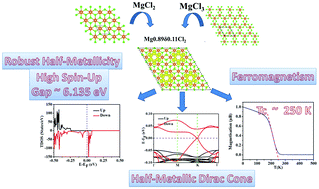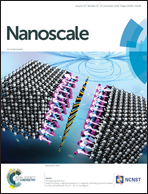Ferromagnetism in magnesium chloride monolayer with an unusually large spin-up gap†
Abstract
The primary research target of the rapidly evolving spintronic industry is to design highly efficient novel materials that consume very low power and operate with high speed. Main group based ferromagnetic half-metallic materials are very promising due to their long spin-relaxation time. In recent years, the discovery of superconducting state with high critical temperature in a magnesium based system (MgB2) invigorated researchers due to its simple crystal structure and intriguing results, leading to its use as a good material for large scale application in electronic devices. Here, we report ferromagnetism and strong half-metallicity in another Mg-based system, which can be a promising material for spintronics based devices rather than for electronic devices (such as MgB2). Based on the first principle calculations, we report here a series of magnetic half-metallic magnesium chloride based monolayers [Mg0.89δ0.11Cl2, Mg0.78δ0.22Cl2, and Mg0.67δ0.33Cl2 (MgCl3)]. This MgCl3 phase has a similar pattern as that in CrI3, which has drawn remarkable attention worldwide as the first intrinsic 2D magnet. These magnesium chloride monolayer based systems are 100% spin-polarized, and promising for scattering-less transport due to strong half-metallicity and large spin-up gap (∼6.135–6.431 eV). The unusually large spin-up gap in our proposed system may shield spin current leakage even in nanoscale device. Further investigation explores a ferromagnetic ordering in Mg0.89δ0.11Cl2 with a Curie temperature of 250 K, which makes the system viable for operation at temperatures slightly lower than the room temperature. High magnetic anisotropy energy (MAE) in Mg0.89δ0.11Cl2 (452.84 μeV) indicates that the energy required to flip the spin is high, and therefore inhibits spin fluctuation. These results suggest a promising way to discover MgCl2-based 2D spin valves, GMR, TMR and other spintronics devices.



 Please wait while we load your content...
Please wait while we load your content...